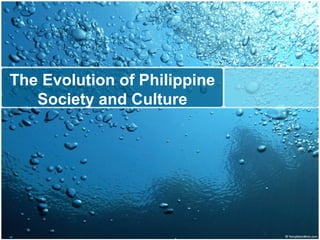
Philippine Culture
- 1. The Evolution of Philippine Society and Culture
- 2. Pre-Colonial Culture, was it Indigenious Culture or Civilization?
- 3. Webster • Defines civilization as the advanced state of human society in which a high level of
- 4. Jocano • ‘’The Vision of our Future must be rooted in our Image of the Past,’’ however, strongly contends that: ‘’Filipinos possessed an elaborate civilization in the past. This achievement did not become part of Filipino consciousness, even today, because of the advent of colonization during which a systematic distortion of our perspectives about ourselves was carried out.’’
- 7. Great Wall of China
- 10. Earlier accepted theories about the origin of the Philippines
- 15. H. Otley Beyer (eminent anthropologist of the American period • The racial mixture of the Filipinos is as follows: – Malay (40%) – Indonesian (30%) – Negrito (10%) – Chinese (10%) – Indian (8%) – American (3%) – Arab (2%)
- 18. • Dr. H.O. Beyer’s migration theory arranged the peopling of the Philippines with the coming of the Dawn Man, the prehistoric cousin of the Java man and Peking man of 250,000 years ago.
- 19. Asian Migrations
- 20. • According to Prof. Beyer, three Asian peoples are: –Negritos –Indonesians –Malays
- 22. Negritos
- 25. Indonesians
- 26. The Malays Came in three waves; First: brought their mining and smelting technology, and their agricultural system. They were headhunters who chiefly depended on hunting, fishing, and fruit gathering. They developed terrace agriculture with elaborate irrigation systems.
- 27. • Second wave: brought their syllable system of writing. They were known as the alphabetusing Malays. • Third wave: the Muslim Malays introduced Islam in the Philippines. – More advanced culturally and economically than the Indonesians. – Their culture belonged to the Iron and Porcelain periods. – Lived in organized communities and had domestic and foreign barter trade, wet agriculture, and industries.
- 29. Malays
- 30. The First Filipino • Tabon Man (22,000-30,000 years ago) – who lived in Palawan. – The skull cap of this Stone Age human was discovered by Dr. Robert Fox inside Tabon Cave in 1962. – Medium height, and had a high eyebrow and sloping forehead,. – Depend on forest fruits, roots and edible plant, and by hunting wild animals.
- 35. First Filipino Communities • Barangays – Units of social organization with broader political, economic, and religious features than the family (Jocano 1975). – 30-100 families had distinct culture of their own. – As political organization, it was a consultative monarchy and was considered the barangays carried on trade and commerce not only among themselves, but also with other foreign entities. – They concluded treaty of friendship and alliance with each other through ritual sanduguan (blood compact).
- 38. Social Classes • Traditional history divided pre-Spanish cosiety into three classes: – The nobles or upper class • The chiefs (Datu or Rajah), their families and relatives – The freemen or middle class • Free-born or freed slaves constituted the majority of the social classes – The dependents or alipins • Aliping namamahay – owned house and properties • Aliping sagigilid – had no right, could be sold anytime by his master, generally they were captives of war
- 39. Spanish Colonial Society • Ferdinand Magellan – The first European to reach the Philippines – A Portuguese explorer commissioned by the Spanish ruler to search for the Spice Islands. • Villalobos – Named the islands “La Felipinas” in honor of Prince Philip, who later became the King of Spain. • Legazpi (1565) – Successfully established the first Spanish settlement in Cebu.
- 41. Roy Lopez de Villalobos
- 43. Encomienda System • Established a feudalistic society which was characterized by a master-slave relationship between the conquistadores and the Indios (natives).
- 45. Doctrine of Limpieza de Sangre (purity of blood) • Creating a social ranking among various groups.
- 46. Peninsulares
- 47. Insulares
- 48. Indio
- 49. Frailocracy (Quasi-Theocratic Society) • “Frailocracia” – “rule of the friars”
- 51. American Colonial Society • Education – The main vehicle of peaceful pacification through education was the establishment of the Public School System by the American-controlled Second Philippine Commission under Taft. – The Commission’s Act No. 74 provided initially for free primary education with English as the medium of instructions.
- 52. • Pensionado system or the scholarship grant to the United States – Another subtle device created by the Americans to project better their benevolence. – It was recorded that by 1912 more than 200 of this pensionados or “Americanization trainees” had obtained their university degrees in the United States.
- 53. Politics • Introduction of democracy – Cooper Act – Jones Law – Tydings-McDuffie Law – Bill of Rights
- 54. Economic Relations • Free trade relations with the United States made the Philippines economically dependent on the United States.
- 55. Miseducation and Colonial Consciousness • Colonial or “Stateside mentality Literature-Agent of Deculturization Literature during this period was divided into two schools of thought: • reactionary school – whose clientele were the collaborators or “Americanistas” •progressive school – whose proponents were from the “irreconcilables”